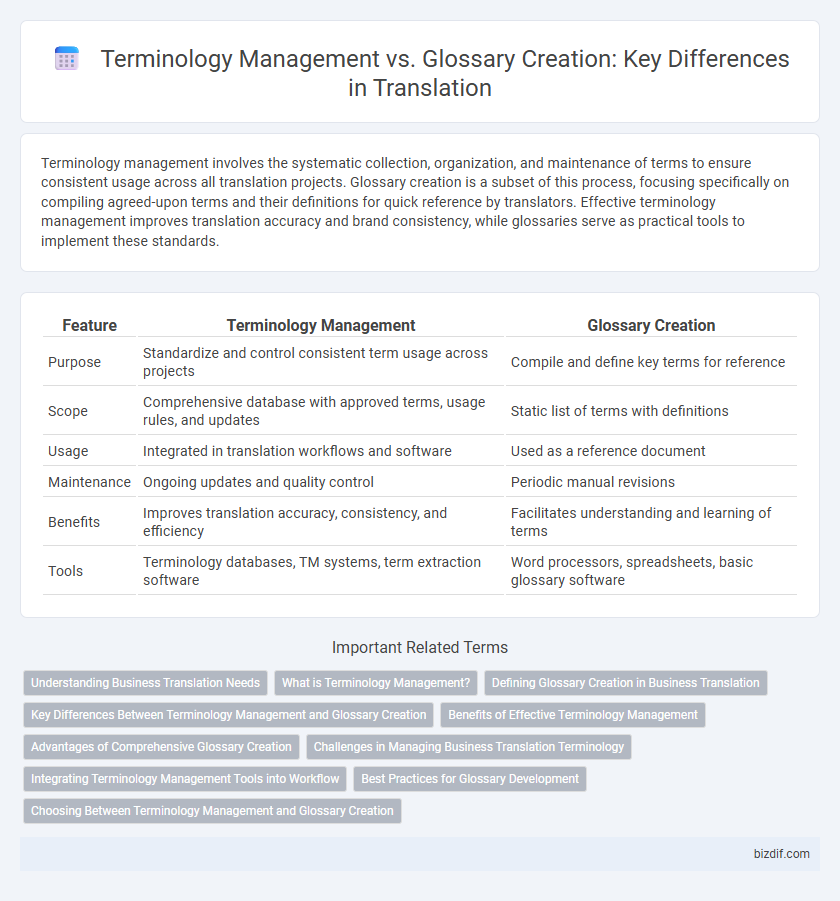Terminology management involves the systematic collection, organization, and maintenance of terms to ensure consistent usage across all translation projects. Glossary creation is a subset of this process, focusing specifically on compiling agreed-upon terms and their definitions for quick reference by translators. Effective terminology management improves translation accuracy and brand consistency, while glossaries serve as practical tools to implement these standards.
Table of Comparison
| Feature | Terminology Management | Glossary Creation |
|---|---|---|
| Purpose | Standardize and control consistent term usage across projects | Compile and define key terms for reference |
| Scope | Comprehensive database with approved terms, usage rules, and updates | Static list of terms with definitions |
| Usage | Integrated in translation workflows and software | Used as a reference document |
| Maintenance | Ongoing updates and quality control | Periodic manual revisions |
| Benefits | Improves translation accuracy, consistency, and efficiency | Facilitates understanding and learning of terms |
| Tools | Terminology databases, TM systems, term extraction software | Word processors, spreadsheets, basic glossary software |
Understanding Business Translation Needs
Effective terminology management ensures consistent use of specialized terms across multilingual business documents, enhancing communication accuracy and brand integrity. Glossary creation supports translators by providing a curated list of approved terms, facilitating faster translation and reducing errors. Understanding business translation needs involves aligning terminology resources with industry-specific language, cultural nuances, and target market expectations for optimal localization results.
What is Terminology Management?
Terminology management is the systematic process of creating, organizing, and maintaining a consistent set of terms within a specific domain to ensure clarity and accuracy in translation projects. It involves the development of comprehensive databases that include definitions, usage contexts, and approved translations, facilitating uniformity across multilingual content. Effective terminology management enhances communication precision, reduces translation errors, and supports efficient localization workflows.
Defining Glossary Creation in Business Translation
Glossary creation in business translation involves compiling a curated list of domain-specific terms with precise definitions to ensure consistent use of vocabulary across all translated documents. This process supports translators by providing authoritative references that align with corporate branding and industry standards. Maintaining an updated glossary enhances communication accuracy, reduces ambiguity, and improves overall translation quality in multinational business environments.
Key Differences Between Terminology Management and Glossary Creation
Terminology management involves systematic collection, organization, and maintenance of terms across multiple projects to ensure consistent usage, while glossary creation focuses on compiling a list of defined terms specific to a single project or domain. Terminology management incorporates workflows, approval processes, and integration with translation memory systems, whereas glossaries serve as static reference tools without ongoing updates or quality control mechanisms. Effective terminology management enhances translation accuracy and efficiency at scale, contrasting with glossary creation's limited scope centered on immediate project needs.
Benefits of Effective Terminology Management
Effective terminology management enhances translation consistency by ensuring uniform use of specialized terms across all documents. It improves communication accuracy, reducing misunderstandings and increasing client satisfaction. Centralized terminology databases streamline workflow, saving time and boosting productivity in multilingual projects.
Advantages of Comprehensive Glossary Creation
Comprehensive glossary creation enhances translation accuracy by providing consistent, context-specific term usage across projects, reducing ambiguities and errors. It supports efficient collaboration among translators and subject matter experts by offering a centralized reference for approved terminology. The glossary's structured format accelerates onboarding and quality assurance, improving overall translation workflow and output consistency.
Challenges in Managing Business Translation Terminology
Managing business translation terminology involves overcoming challenges such as maintaining consistency across large volumes of multilingual content and ensuring real-time updates in evolving markets. Terminology management systems require integration with translation workflows to prevent semantic discrepancies and enhance accuracy. Glossary creation alone often lacks scalability and dynamic updating features, making comprehensive terminology control difficult in complex business environments.
Integrating Terminology Management Tools into Workflow
Integrating terminology management tools into the translation workflow enhances consistency and accuracy by automating term recognition and usage across projects. These tools enable real-time updates and synchronization with translation memories, reducing errors and improving efficiency for linguists. Streamlined terminology management fosters collaboration among translators, reviewers, and project managers, ensuring standardized language across all content deliverables.
Best Practices for Glossary Development
Effective glossary development involves systematically collecting, defining, and updating domain-specific terms to ensure consistency and clarity in translation projects. Employing terminology management tools facilitates real-time collaboration and version control, reducing errors and improving communication among translators and subject matter experts. Maintaining alignment with industry standards and regularly reviewing entries enhances accuracy and usability, supporting efficient and reliable multilingual content production.
Choosing Between Terminology Management and Glossary Creation
Choosing between terminology management and glossary creation depends on the scope and complexity of the translation project. Terminology management involves continuously updating and maintaining a centralized database of terms for consistency across multiple projects, ideal for large-scale or ongoing translation needs. Glossary creation provides a static list of key terms and definitions, suited for smaller, one-time projects requiring quick reference and uniform vocabulary.
Terminology Management vs Glossary Creation Infographic

 bizdif.com
bizdif.com